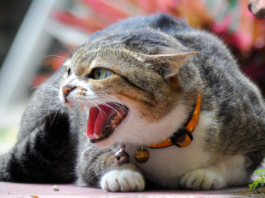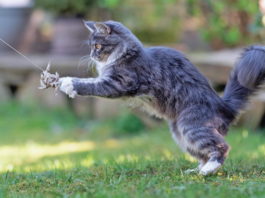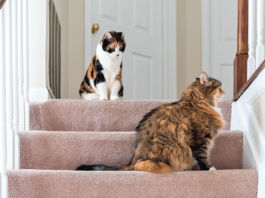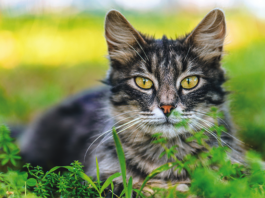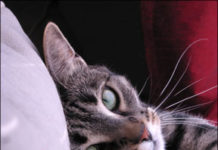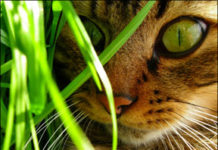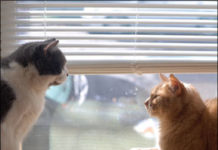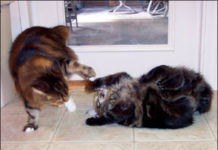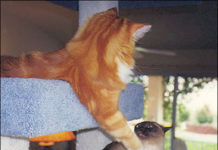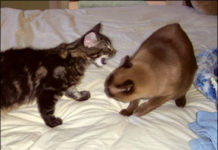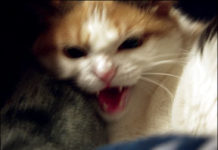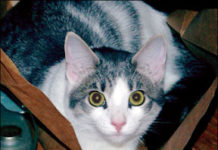Keep a Feline Health Diary
If your cat kept a diary, it might read something like this: Yesterday, I slept, ate, slept some more, chased a paper ball, napped, ate again and napped. While that may describe a cats typical day, it wont necessarily help you or your veterinarian if your cat develops a health or behavior problem. "Keeping a diary for your cat is a good idea in general, but particularly when your cat is ill," says Drew Weigner, DVM, who is board-certified by the American Board of Veterinary Practitioners. Keep Track of the Basics. At a minimum, you should track your cats veterinary visits, vaccinations, flea treatments and any medications your cat takes. Beyond that, record anything that is unusual for your particular pet. For example, if you change your cats diet, note the date and track changes (such as vomiting or diarrhea). Or, if your cat urinates more or less often than usual, record that in the diary. "If there is anything unusual, or if you start seeing something more often, you should take a trip to the veterinarian," says Dr. Weigner, whose practice is The Cat Doctor in Atlanta, Georgia. If your cat exhibits any changes in behavior, you should note anything unusual thats happened in the house, such as human visitors or changes in the environment. Are strange cats hanging around outside? "Anything can act as a trigger," says Dr. Weigner. "Keeping a journal helps separate the subjective from whats objective. If you keep a log of it, you know for sure."
How to Curb Destructive Scratching
Not long after youve invested in new furniture, your cat picks her favorite spot. And its not where she wants to take a nap, either. Its the place shes chosen to give herself a pedicure, and soon that beautiful new sofa looks like its gone through a shredder. Why Cats Claw. You may notice your cat flexing her nails when she first gets up and stretches or suddenly stop to sink her nails into the wall-to-wall carpeting as she crosses a room. She may scratch at the end of a burst of energy after playing with her favorite toy. Fabrics, carpet, wood, cardboard anything in your house made of materials your cat can sink her nails into can become a target for her clawing. "Clawing helps them shed the outer layer of their nails," says Katherine Houpt, VMD, PhD, and the James Law professor of Behavior Medicine at Cornell Universitys College of Veterinary Medicine. In addition to having a practical purpose, clawing serves a more esoteric function. Cats indoors and out leave olfactory and visual signals on the surfaces of whatever material they claw. "Indoors, cats leave the marks on well-traveled areas like doorways or in more obvious locations like the ends of a sofa," says Dr. Houpt.
Do Cats Exhibit Vengeful Behavior?
Vacations are wonderful, but theres nothing like home sweet home. You drive home from the airport, excited at the thought of sleeping in your own bed, and seeing your beloved cat. And she does seem happy to see you, greeting you with enthusiasm and sharing a few cuddles. Then you go off to unpack, and there she goes - right into your suitcase, urinating on top of your folded clothes. To you, it may feel like your cat is angry because you left her - and this is the way shes making her feelings known. But can a cat really hold a grudge? Experts look at it in another way. Cats and Vengeance. Ask many cat companions, and they will say "yes." They swear that cats can and will be vengeful at times. Besides suitcase antics, people point out the times their cats bite them minutes, or even hours, after they did something their cat disliked - such as grooming it. But animal behaviorists disagree.
Cats Eyes: Exquisitely Fascinating
Ever feel like you could get lost in your cats eyes? Although we usually associate cats eyes with the color green, they actually come in many colors. They can range from blue to copper, with a variety of blue-green shades in between. (But all kittens are born with blue eyes - the same as human babies.) The color of the iris (the oval area around the pupil) is caused by the pigment melanin, and in cats it ranges from very pale yellow or tan to deep orange or brown. "The eye also derives some pigment from the retina in the back of the eye, causing a blue-grayish color," says Paul Maza, DVM, of the Department of Biomedical Sciences in Cornell Universitys College of Veterinary Medicine. The end result can be compared to putting a sheet of blue-gray glass over the iris, thus resulting in your cats unique eye color. Since a cats eye color depends on several genetic factors, one set of feline parents can produce a wide range of eye colors in their kittens.
Who Are You, Anyway?
Lets be honest: Anyone can have a bad day. Maybe the car wouldnt start. Or you forgot to set the alarm and were late for an important meeting. You might have snapped at a loved one who asked a simple question. When bombarded with an unidentified scary sound, a cat may believe that she is under attack. Perhaps your painter needed to power-wash the deck. Maybe something triggered your neighbors alarm system. Nellie, a nervous kitty, could take refuge in the closet. Or, she may instead attempt to learn the source of the scare. She will take a mental snapshot of the scene. Anything in the picture becomes suspect. Her housemate, Sue, seems a likely culprit. Frightened cats are not reasonable, and fear is a powerful trigger for aggression. Without taking time to recall that Sue has always been a friendly companion, Nellie initiates an attack. Naturally, Sue will be caught off guard. She could fight back, or will probably head for cover. As your day improves, you will probably get back on track. The victim of your ill humor - understanding that your behavior was nothing personal - will still treat you kindly. If only our cats could be as understanding. Sadly, a hiss, growl or swat from a trusted feline companion may set off a cycle of aggressive behavior that can take weeks, months or even years to resolve. Sometimes, an inciting event can clearly be identified. Often, folks come home to find that their cats seem to be at war.
Short Takes: 10/08
In a recent issue of the Journal of the American Veterinary Medical Association (JAVMA Vol. 233, Number 4), the article, "Evaluation of inciting causes, alternative targets and risk factors associated with redirected aggression in cats," describes a typical case of redirected aggression like this: Your indoor cat is watching through the window. Along comes a neighborhood cat, which makes your cat really mad. Suddenly, your normally sweet pet attacks you instead. Redirected aggression is one of the most commonly reported problems to animal-behavior experts, who take the problem seriously: "Bites from aggressors are uninhibited, attacks are usually difficult to stop, and aggressors typically remain highly aroused long after the inciting event is over," according to the JAVMA report. Sometimes all it takes is a loud noise to trigger an episode of redirected (also called displaced) aggression. (For more information on cat fights, please see related article on page 3 of this issue.)
Cat Fights: What to Do?
While fighting among cats is not typical behavior, it does happen. Read on to learn some reasons why cats pick fights with each other - and what you can do about it. All kittens play, practicing to defend themselves by arching their backs, jumping on each other, chasing each other and maybe exchanging a few nips on the ears. "The difference between playing and fighting," says Katherine A. Houpt, VMD, the James Law Professor of Animal Behavior, Cornell Universitys College of Veterinary Medicine, "is that when playing, cats take turns chasing each other. There isnt one dominant aggressor or one main victim. Nobody hides." In general, cats dont play much after 16 months of age, and males are more likely to engage in play of this kind. As for fighting, cats will fight at any age. "True fighting is usually more of a one-way process," says Dr. Houpt. "One cat will be the aggressor and the other will be the victim. Hissing, clawing and batting with the paws are more fear-directed than playful. The noisier the interaction, the more likely its a fight and not play."
Understanding Your Cat’s Body Language
You have a group of people over for dinner. While everyone is relaxing in the living room, the boss of the house walks in: your cat. All of your guests clamor for your cat to come over, except for one, who doesnt make much of a fuss, because he hates cats. So who does your cat check out? The one guest who doesnt welcome his company, of course. Why does this happen? The answer is eye contact, or rather, the lack of eye contact. Some animal behaviorists conjecture that prolonged eye contact makes cats feel threatened or provoked. When your cat walks into the room, she senses everyones eyes on her. However, there is one person who is not staring at her - the guest who hates cats - so thats why she probably chooses to approach him; she just feels more comfortable with that person.
The Aggressive Kitten
Who doesnt love a kitten? They're so soft when we just need something to touch. They're so funny to watch after a hard day at the office. They're so easy to entertain when we want to relax. Whenever we adopt a kitten, we can expect to be the recipients of small "mistakes." There may be an attention-seeking swat that tears our pantyhose. Or a scratch when the toy moves out of reach faster than our arm does. Maybe even a nip when we attempt to play cat and mouse using our hands as the target.
Do You Have a Watchcat on Patrol?
Over the years, I have seen a handful of cats that exhibited aggression toward visitors to the home. If you have never witnessed a cat that thinks he is a German shepherd guarding a door, let me assure you: It is a scary sight to behold. I am referring to a cat that, upon hearing the doorbell, marches to the door, stares as guests enter, and proceeds to demonstrate postures that clearly reflect the message: "Go home, stranger."
Coping With Redirected Aggression
Have you ever been close to a truly frightened cat? You might picture a cat peeking out from under furniture in fear of being groped by a toddler. Veterinarians of course routinely cope with cats plastered to the sides of their carriers, hanging on with all their strength. Some of us have also witnessed a cat as he suddenly puffed up, ears flattened against his head, eyes black and vocalizing in a spine tingling manner.
Short Takes: 03/07
"Helping Owners Handle Aggressive Cats" is animal-behavior consultant Wayne Hunthausens advice for veterinarians who counsel concerned cat people who, like us, never knew there were so many reasons for cats to attack. He lists 11 possible types of feline aggression: "Fear-induced, play, redirected, petting-induced, territorial, inter-male, maternal, pain-induced, learned, pathophysiological and idiopathic."


